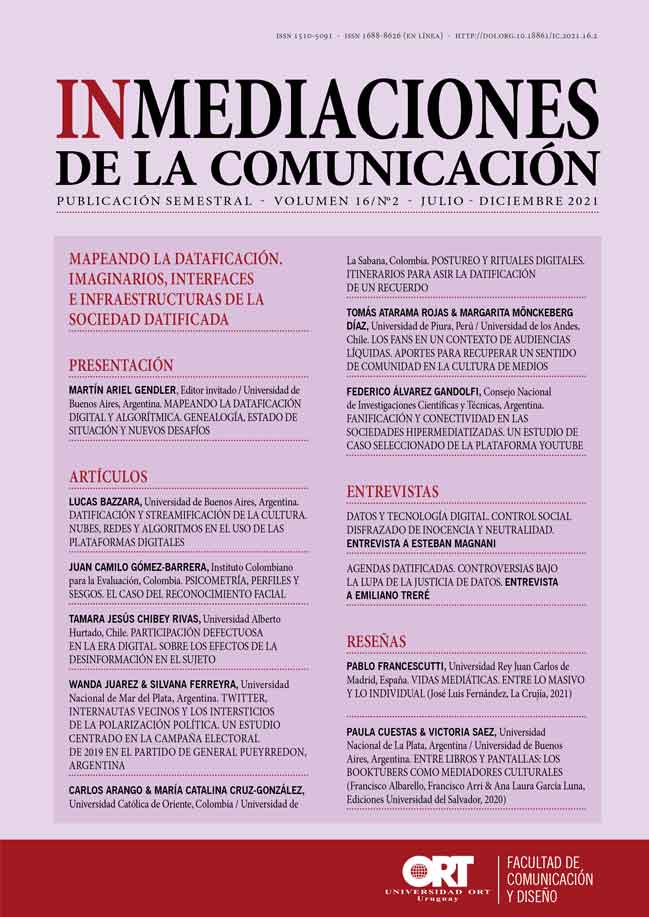Psicometria, perfis e vieses
O caso do reconhecimento facial
DOI:
https://doi.org/10.18861/ic.2021.16.2.3156Palavras-chave:
psicometria, perfil-dividuo, reconhecimento facial, viesesResumo
Os estudos psicométricos permitem realizar medições baseadas em correlações de vetores que produzem previsões de traços comportamentais humanos. Com o aumento da digitalização, a psicometria tem sido usada para projetar perfis de indivíduos por meio de vários mecanismos: Big Data, Machine Learning, entre outros. Longe de serem neutros, esses perfis baseiam-se em metodologias que produzem vieses que afetam os indivíduos perfilados. Este artigo apresenta que a psicometria desenvolve um perfil-dividuo gerando uma redução dos indivíduos e produz formas que pressagiam como eles deveriam se comportar. Aqui a conjectura é exemplificada a partir da análise de um caso de medição psicométrica baseada no reconhecimento facial.
Downloads
Referências
Ballew, C. & Todorov, A. (2007). Predicting political elections from rapid and unreflective face judgments. Proceedings of the National Academy of Sciences, 104, 17948-17953.
Benjamin, R. (2019). Race after technology: Abolitionist tools for the new jim code. Oxford: Social Forces.
Berns, T. & Rouvroy, A. (2016). Gubernamentalidad algorítmica y perspectivas de emancipación. ¿La disparidad como condición de individuación a través de la relación? Adenda Filosófica, (1), 88-116.
Bishop, C. (2006). Pattern Recognition and Machine Learning. Berlin: Springer.
Brand, S. (1994). How buildings learn: What happens after they´re built. New York: Viking-Penguin.
Cao, Q., Shen, L., Xie, W., Parkhi, O. M. & Zisserman, A. (2018). Vggface2: A dataset for recognising faces across pose and age. In AA.VV., IEEE International Conference on Automatic Face & Gesture Recognition (pp. 67-74). DOI Bookmark: 10.1109/FG.2018.00020
Carpinella, M. & Johnson, K. (2013). Appearance-based politics: Sex-typed facial cues communicate political party affiliation. Journal of Experimental Social Psychology. 49(1), 156-160. Recuperado de: https://doi.org/10.1016/j.jesp.2012.08.009
Deleuze, G. (1999). Posdata sobre las sociedades de control. En Ferrer, C. (Ed.), El lenguaje libertario. Antología del pensamiento anarquista contemporáneo (pp. 101-109). Buenos Aires: Altamira.
Geisinger, K. (Ed.) (2013). APA Handbook of Testing and Assessment in Psychology. Vol 1. Test Theory and Assessment in Industrial and Organizational Psychology. Washington, DC: American Psychological Association.
Gelman, A. (2013). Bayesian Data Analysis. London: CRC.
Gómez-Barrera, J. (2020). Las huellas digitales del comportamiento humano: gustos, neoliberalismo y algoritmos. MEDIAÇÕES, 25(3). DOI: 10.5433/2176-6665.2020.3v25n3p712
Hill, K. (June 24, 2020). Wrongfully Accused by an Algorithm. The New York Times. Recuperado de: https://www.nytimes.com/2020/06/24/technology/facial-recognition-arrest.html
Holden, D. (2000). Psycometrics. In Kazdin, A. (Ed.), Encyclopedia of psychology (pp. 417-419). New York: Oxford University Press.
Jones, L. & Thissen, D. (2007). A History of Overview of Psychometrics. In Rao, C. & Sinharay, S. (Ed.), Handbook of Statistics 26. Psychometrics (pp. 1-27). Amsterdam: Elsevier.
Kosinski, M., Stillwell, D. J. & Graepel, T. (2013). Private traits and attributes are predictable from digital records of human behavior. Proceedings of the National Academy of Sciences,110, 5802-5805.
Kosinski, M. (2021). Facial recognition technology can expose political orientation from naturalistic facial images. Nature Research, 11. DOI: https://doi.org/10.1038/s41598-020-79310-1
Lipton, Z. C. (2016). The Mythos of Model Interpretability: In machine learning, the concept of interpretability is both important and slippery. Queue, 16(3), 31-57.
Markman, A. (1998). Knowledge representation. Mahwah: Erlbaum.
Martínez, A., Hernández, M. & Hernández, L. (2006). Psicometría. Madrid: Alianza.
Messick, S. (1989). Validity. In Linn, R. (Ed.), Educational measurement (pp. 13-103). New York: American Council on Education/Macmillan.
Mislevy, R.J. & Gitomer, D. H. (1996). The role of probability-based inference in an intelligent tutoring system. User-Modeling and User-Adapted Interaction, 5, 253-282.
Redacción MIT Technology Review (1 de marzo de 2021). Ocho predicciones sobre el impacto de la tecnología en nuestra vida en 2021. MIT Technology Review. Recuperado de: https://www.technologyreview.es/s/13212/ocho-predicciones-sobre-el-impacto-de-la-tecnologia-en-nuestra-vida-en-2021
Muñiz, J. (2003). Teoría clásica de los tests. Madrid: Pirámide.
Pasquinelli, M. & Joler, V. (May 1, 2020). The Nooscope Manifested: Artificial Intelligence as Instrument of Knowledge Extractivism. KIM HfG Karlsruhe and Share Lab. Recuperado de: https://nooscope.ai
Pearl, J. (1988). Probabilistic Reasoning in Intelligent Systems. San Francisco: Morgan Kaufmann.
Roberts, T. & Bruce, V. (1988). Feature saliency in judging the sex and familiarity of faces. Perception, 17, 475-581.
Rodríguez, P. (2019). Las palabras en las cosas: saber, poder y subjetivación entre algoritmos y biomoléculas. Buenos Aires: Cactus.
Rule, N. & Ambady, N. (2008). The face of success: Inferences from Chief Executive Officers’ appearance predict company profits. Psychol Sci, 19, 109-111.
Rule, N. & Ambady, N. (2010). Democrats and Republicans can be differentiated from their faces. PLoS ONE (5). DOI: https://doi.org/10.1371/journal.pone.0008733
Rule, N., Ambady, N., Adams, R. & Macrae, C. (2008). Accuracy and awareness in the perception and categorization of male sexual orientation. Journal of Personality and Social Psychology, 95, 1019-1028.
Rust, J. & Golombok, S. (2009). Modern Psychometrics. The Science of Psychological Assessment. London: Routledge.
Rust, J., Kosinski, M. & Stillwell, D. (2021). Modern Psychometrics: The Science of Psychological Assessment. London: Routledge.
Sampson, E. E. (1981). Cognitive psychology as ideology. American Psychologist, 36, 730-743.
Segalin, C., Celli, F., Polonio, L., Kosinski, M., Stillwell, D., Sebe, D., Cristani, M. & Lepri, B. (2017). What your Facebook Profile Picture Reveals about your Personality. Proceedings of the 25th ACM international conference on Multimedia, 460-468. DOI: https://doi.org/10.1145/3123266.3123331
Sibley, C. G., Osborne, D. & Duckitt, J. (2012). Personality and political orientation: Meta-analysis and test of a Threat-Constraint Model. Journal of Research in Personality, 46(6), 664-677.
Stevens, S. (1946). On the theory of scales of measurement. Science, 106, 667-680.
Suárez, M. (2004). An inferential conception of scientific representation. Philosophy of Science, 71, 767-779.
Swoyer, C. (1991). Structural representation and surrogative reasoning. Synthese, 87, 449-508.
Wang, Y. & Kosinski, M. (2018). Deep Neuoral networks are more accurate than humans at detecting sexual orientation from facial images. Journal of Research in Personality, 114(2). DOI: 10.1037/pspa0000098
Zebrowitz, L. (1997). Reading faces: Window to the soul? Boulder: Westview Press.
Publicado
Como Citar
Edição
Seção
Licença

Este trabalho está licenciado sob uma licença Creative Commons Attribution 4.0 International License.





